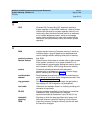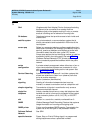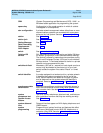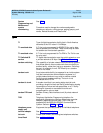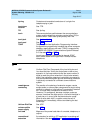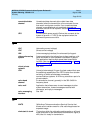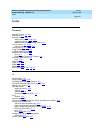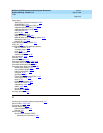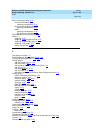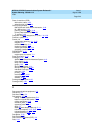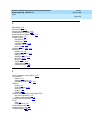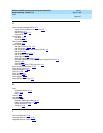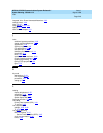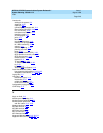
MERLIN LEGENDCommunications System Release 6.1
System Planning
555-661-112
Issue 1
August 1998
Index
Page IN-3
BRI line options planning, 3–44
clock synchronization
planning considerations, 3–46
Service Profile Identifier (SPID)
planning considerations, 3–45
timers
planning considerations, 3–48
planning form instructions, 3–48
Broadcast Music Incorporated (BMI), 3–9
Buttons
assigning, 3–55
assigning in Behind Switch mode, 3–57
assigning in Hybrid/PBX mode, 3–52
assigning in Key mode, 3–57
factory assignments, 3–57
C
Calculating unit loads, F–2
Call Management System (CMS), 2–23, 2–34
Call-by-Call Service Selection, 3–3, 3–36
Calling Groups
and dial-in trunks
, 3–16, 4–34
and DID trunks, 3–42
and Incoming Call Line Identification (ICLID), 3–4
and Pools, 3–16
and Remote Access, 3–19
and Tie trunks, 3–40
interaction with Music on Hold and External Page Port trunks, 3–4
Calling groups
Calls-in-Queue alarm threshold
, 4–35
extension number, 4–33
Extension Status, 4–32, 4–44
external alert for, 4–36
Hunt type, 4–35
MERLIN LEGEND Mail, 4–33
Message Waiting receiver, 4–35
names, 4–33
options, 4–35
overflow coverage, 4–39
overflow threshold, 4–36
overflow time threshold, 4–40
overview, 4–32
types, 4–40
Calling Restrictions, 5–37
Calling restrictions, 5–35, 5–37
overview, 4–5, 4–53
Calls-in-Queue alarm threshold, 4–35
Calls-in-Queue alert, 4–20
Camp-On, 4–43
Capacity
lines/trunks
, 2–2
Centralized programming, 4–2
Centralized Voice Mail, 2–32
CentreVu Computer-Telephony Services for Windows NT, 2–26, 2–28
Centrex, 3–3
Channel service unit (CSU), 3–27



